If you’ve ever spent time in the swamps or rivers of the southeastern United States, then chances are good that you’ve seen a cottonmouth snake. They’re known as dangerous pests that can sometimes infest waterways and even fall into canoes passing under trees.
Their bites pack a deadly punch and cottonmouths can grow to be quite large. Just how large? Let’s find out.
Here, we’ll learn more about cottonmouths, and how to identify them in the wild. Then, we’ll go over just how big they get, and discuss the largest ever reliably measured cottonmouth. We’ll learn more about other names for cottonmouths, then compare them to the similar copperhead snake.
Finally, we’ll go over the steps you should take if a cottonmouth bites you.
What Do Cottonmouth Snakes Look Like?
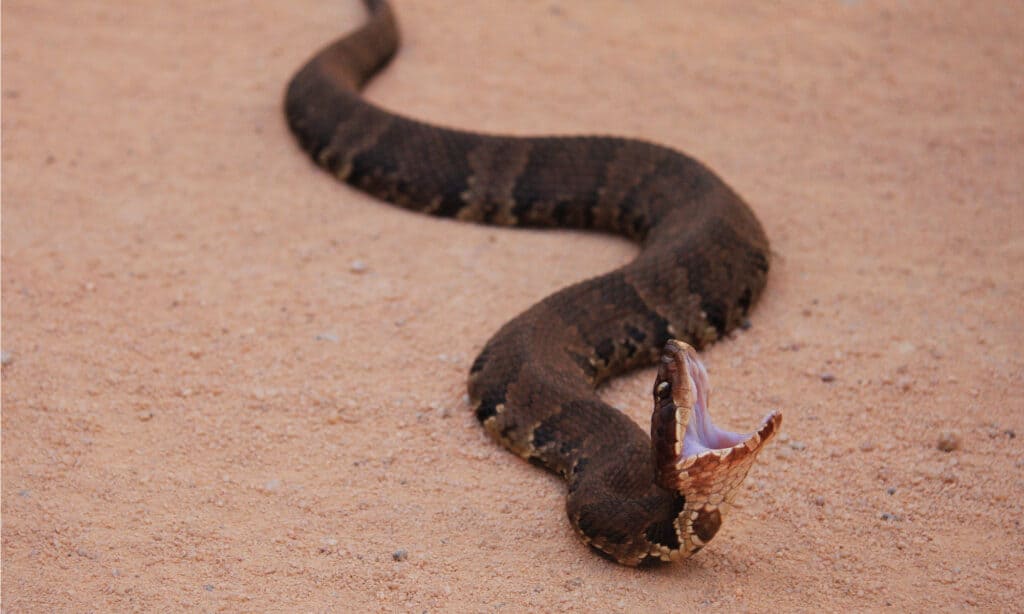
The cottonmouth is one of the most common snakes in the southeastern United States.
©Nathan A Shepard/Shutterstock.com
Cottonmouths (Agkistrodon piscivorus) live throughout the hot, humid areas of the southeastern United States. They’re water-loving snakes almost always seen either in or near sources of freshwater. Like rattlesnakes, they have wide, leaf-shaped heads designed to accommodate large venom glands. Perhaps their most distinct feature actually lies inside of their mouths, a cotton-white interior, which is on display when the snakes feel threatened.
Cottonmouths start life with distinct bands of tan and light brown, gradually growing duller in color as they age. By the time they reach adulthood, cottonmouths have turned a medium brown, with some markings visible along their sides. They’re usually seen on the ground hunting for rodents, reptiles, or amphibians, or draped on branches overhanging sources of water.
How Big Can Cottonmouths Get?
Cottonmouths typically grow to a maximum length of four feet, but larger specimens are by no means unheard of. Reports of monstrous cottonmouth snakes are common, but reliably measured giant cottonmouths are much rarer.
Adults have relatively heavy bodies and may appear larger when swimming due to the fact that most of their body rests above the water as they swim.
Cottonmouths are fairly light for their size; most weigh less than three pounds. But, for those few snakes that grow to gigantic proportions (over five feet), their weight may exceed five pounds. Some have even been reported to weigh almost ten pounds, though this may be exaggerated.
Certainly, the largest cottonmouth snakes ever recorded weigh much more than their more average-sized brethren.
The Largest Cottonmouth Snake Ever (Reliably) Recorded

In the wild, the largest cottonmouth snakes ever recorded measured between 60-74 inches. 60 inches is massive for a cottonmouth, though not unheard of for the largest specimens. A 1990 review of snakes included the largest cottonmouth snake ever reliably measured.
This specimen was reputedly captured on the Virginia-North Carolina border, in an area known as the Dismal Swamp. According to the 1990 review, it measured 74 inches long, making it the longest cottonmouth snake ever recorded.
Other cottonmouth specimens have been estimated at 8-9 feet long, though these reports are unverified and likely exaggerated. For a cottonmouth, five feet is huge, and six feet is almost unheard of. Rest assured—no matter the size of the cottonmouth, a bite can still send you to the hospital.
But, are cottonmouths the only venomous snake you need to worry about when exploring the waters of the southeastern United States?
Are Water Moccasins the Same Thing as Cottonmouths?
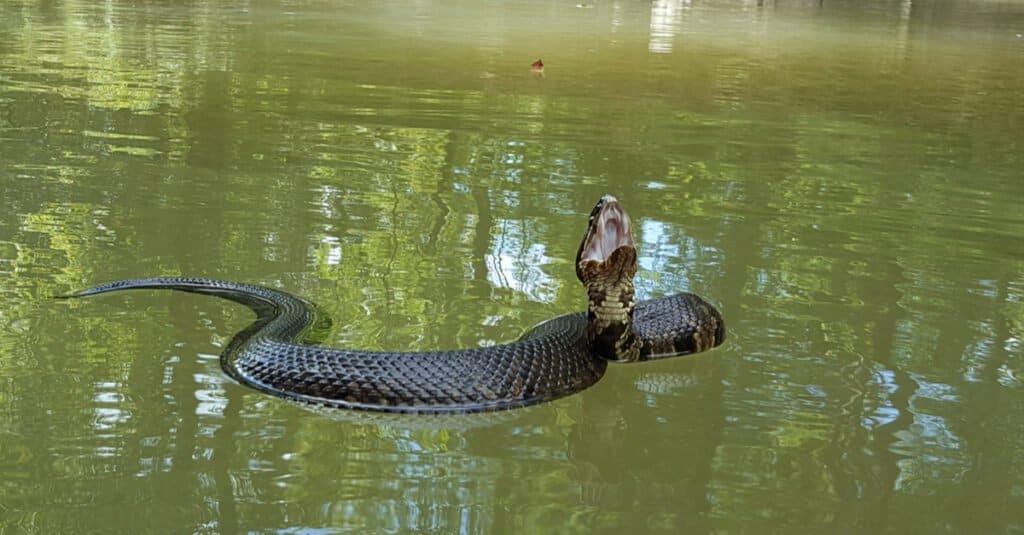
The largest cottonmouths measure up to 74 inches long.
©Seth LaGrange/Shutterstock.com
You may have heard not only of cottonmouths but of water moccasins. They’re actually the same species. Cottonmouths are sometimes called water moccasins, black moccasins, or swamp moccasins because of their semi-aquatic nature. People often confuse them with other types of snakes, like non-venomous water snakes, or venomous copperheads.
No matter what you call them, cottonmouths are not a snake to mess around with. They defend themselves and their territory aggressively, particularly from humans. When threatened, cottonmouths coil into a tight ball, with their head raised in the center, and display the cottony interior of their mouth. They follow up this threat display with one or several bites if the intruder happens to get too close.
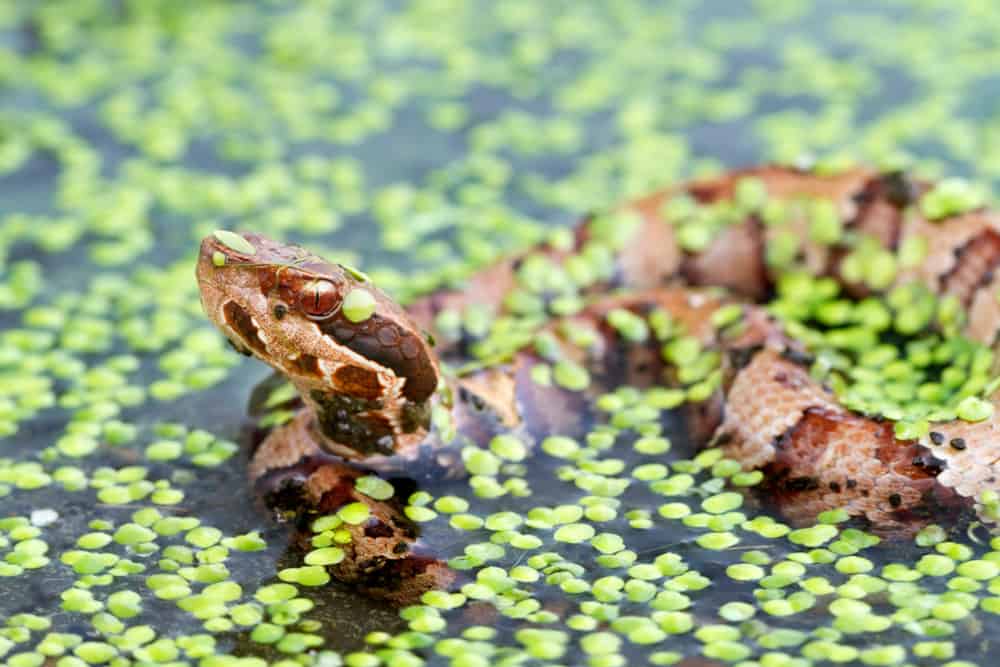
It’s been said that cottonmouths can’t bite underwater – it is untrue – they most certainly can.
©Mark_Kostich/Shutterstock.com
What do Cottonmouth Snakes Eat?
Cottonmouths eat both warm and cold-blooded prey that includes other snakes, fish, frogs, salamanders, lizards, small turtles, baby alligators, birds, mice, and other small mammals. They are known to scavenge and are attracted to dead fish. Cottonmouths hunt primarily at night but are known to hunt during daylight as well. They hunt fish, so they can bite underwater – contrary to urban legend.
Which is Worse: Cottonmouth or Copperhead?
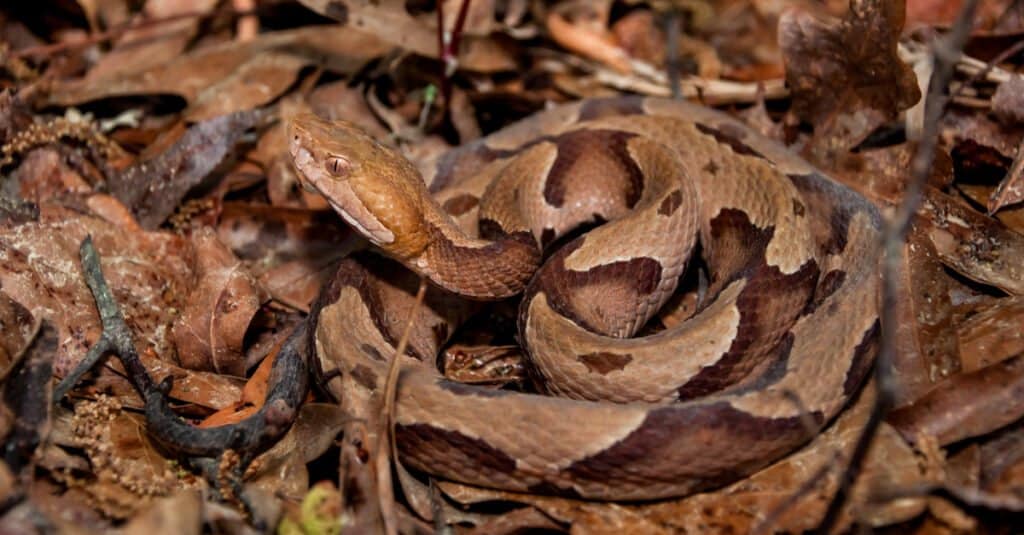
Copperhead venom is less potent than cottonmouth venom.
©Jay Ondreicka/Shutterstock.com
Copperhead snakes, who get their name from very obvious coppery tones on their head and body, are a very common snake to see in North America. Living in similar and overlapping environments with cottonmouths, the two snakes are often confused with the other.
Cottonmouths and copperheads are both pit vipers, a family of snakes characterized by the thermal-sensing facial glands that make them accurate, specialized hunters. These snakes are highly aggressive and will not hesitate to strike if threatened. Copperheads, unlike cottonmouths, are solely land-dwellers and are not found in the water.
The largest cottonmouth snake ever recorded makes copperheads look tiny in comparison; the largest copperheads grow to around 3.5 feet long with the largest on record measuring 53 inches (4 feet, 5 inches).
While both species are venomous, only one has a bite that requires immediate hospitalization. Cottonmouth snake venom is significantly more potent than copperhead venom. Copperhead snakes are often shy, but their excellent camouflage leads to the issue of human-snake contact.
While copperheads bite more people than any other venomous snake in the United States, envenomation is rarely life-threatening. The mortality rate of Copperhead snake bites stands at just .01%.
Cottonmouth snakes, on the other hand, are more aggressive but come into contact less often with people. In 2017, there were 255 envenomation incidents with cottonmouths. 242 were treated by healthcare professionals and 10 patients had severe symptoms, however, none died. It’s important to remember that cottonmouth bites can be quite harmful and you should seek medical attention if bitten.
You might also be interested in comparing the cottonmouth to the rattlesnake and learning about the largest rattlesnake ever recorded.
What to do if a Cottonmouth Bites You?
If you sustain a bite from a cottonmouth snake, the most important thing to do is get away from the snake. Do not attempt to capture or kill it, as this is more likely to result in additional bites than do any good.
When it comes to mitigating the effects of venom, the faster you get antivenom, the better. Remember—it doesn’t matter if the snake that bit you is one of the largest cottonmouth snakes ever recorded, or just a baby cottonmouth, the venom can still kill you if left untreated.
If bitten, remain calm, and call 911. Keep the bitten area below the level of your heart—this will slow the spread of the venom. Remove any jewelry or clothing near the bite, as the area swells up, these things could cause tissue damage due to constriction.
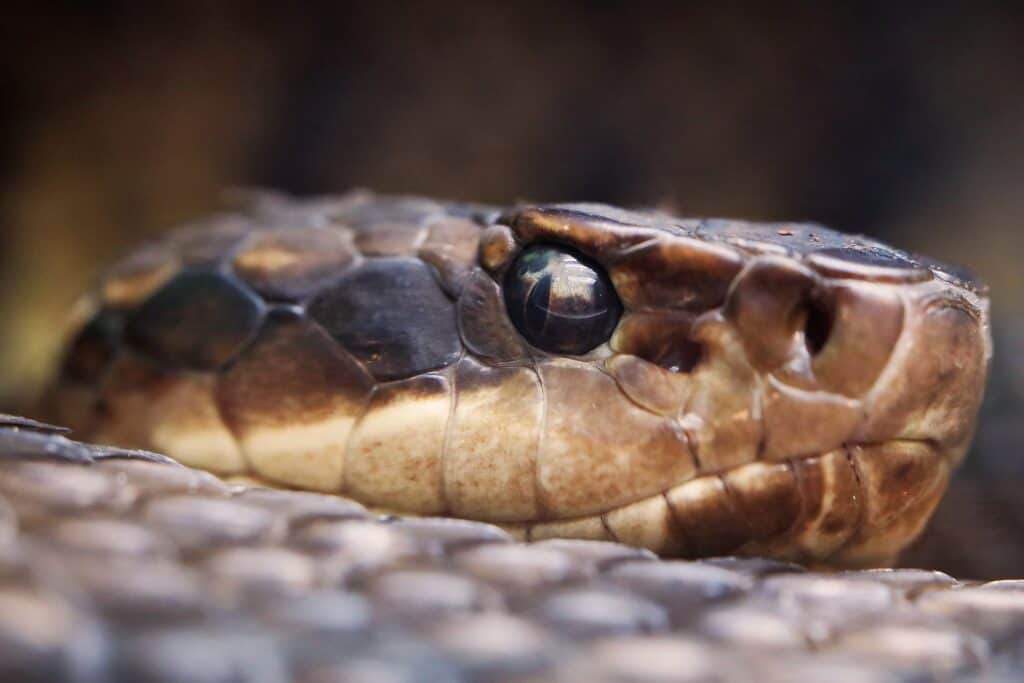
Cottonmouth Water Moccasin Close up
©Nicole Ramsey/Shutterstock.com
You don’t need to ice the area or try to suck out the venom. Just keep the bite clean and dry, and get to a hospital for antivenom.
Where Do Cottonmouth Snakes Live?
Cottonmouth snakes range from South Eastern Virginia all the way to Florida. They can also be found in central Texas as well as north to southern Illinois and Indiana. The state that is recorded to have the most cottonmouth snakes is Texas.
Their habitat consists of wet areas. This can include streams, marshes, lakes, retention ponds, and even roadside ditches. Although they need a wet environment to thrive, they can wander far from watery areas.
How Long Do Cottonmouth Snakes Live?
Cottonmouth snakes have an average lifespan of about ten years. Although experts aren’t sure how long exactly a cottonmouth can live in the wild. The snakes are able to live much longer in captivity, some living over 24 years old.
Cottonmouth vs. Alligator: Who Would Win?
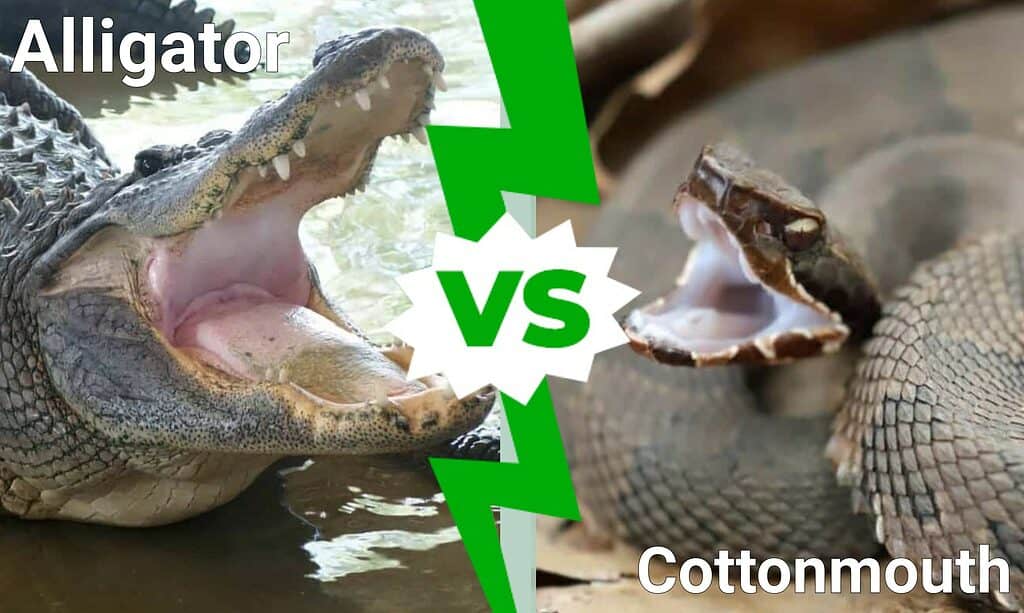
The short answer here would be the alligator. In fact, there is a video here where a cottonmouth in Florida is seen falling prey to a hungry alligator. In the video, the cottonmouth comes out of the water onto a patch of grassy wetland. An alligator can then be seen stalking the cottonmouth from behind.
In a flash, the alligator lunges toward the cottonmouth shaking it violently and bringing it back into the water. The cottonmouth is seen struggling for its life but loses the battle with the apex predator.
Other Record-Breaking Snakes
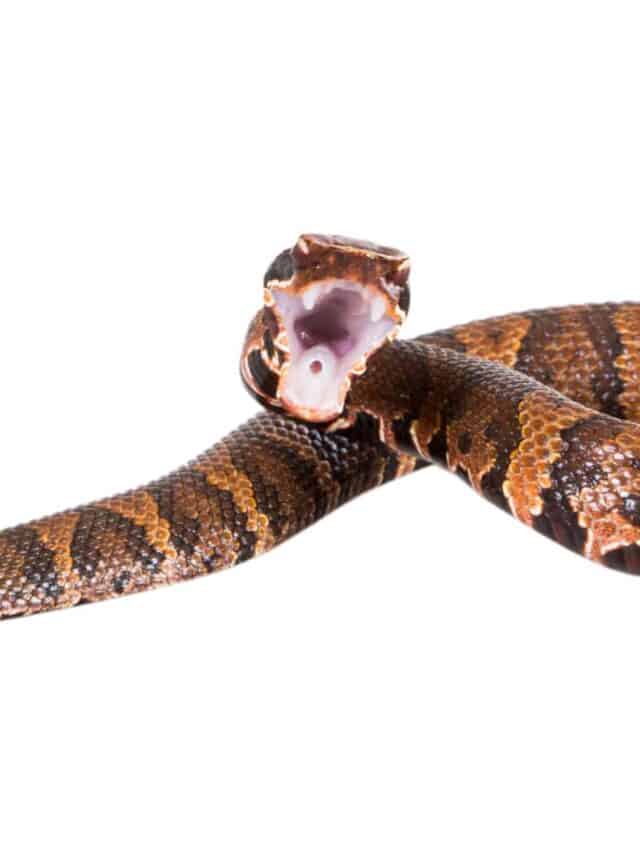
American Copperhead (Agkistrodon contortrix)
©IrinaK/Shutterstock.com
Copperhead snakes are venomous pit vipers that are typically found in North America. They have distinctive copper-colored heads, which is where they get their name from. These snakes can grow up to three feet long on average and are known for their aggressive behavior when threatened.
The Largest Copperhead Snake Ever Recorded was an exceptional specimen that measured four feet and five inches long. This record-breaking snake was discovered in Georgia, USA, back in 1957 by a group of hunters who stumbled upon the massive reptile while out hunting.
This giant copperhead would have been an incredible sight to behold, with its size dwarfing most other specimens of this species. While it’s not entirely clear why this particular snake grew so much larger than others of its kind, it’s possible that it had access to more food or lived longer due to favorable environmental conditions.
Up Next…
Keep reading! We think you’ll like these other pages about snakes and other amazing animals.
- The 10 Largest Pythons in the World
- 2 Snakes That Change Color to Blend In (Plus Snakes That Do It for Other Reasons)
- Discover The Venomous Arctic Snake That Survives -57° Bitter Cold
- California’s Poisonous Snakes
- 6 Poisonous Snakes in Georgia: The 6 Snakes You Should Watch Out For!
The photo featured at the top of this post is ©
Discover the "Monster" Snake 5X Bigger than an Anaconda
Every day A-Z Animals sends out some of the most incredible facts in the world from our free newsletter. Want to discover the 10 most beautiful snakes in the world, a "snake island" where you're never more than 3 feet from danger, or a "monster" snake 5X larger than an anaconda? Then sign up right now and you'll start receiving our daily newsletter absolutely free.
Thank you for reading! Have some feedback for us? Contact the AZ Animals editorial team.






